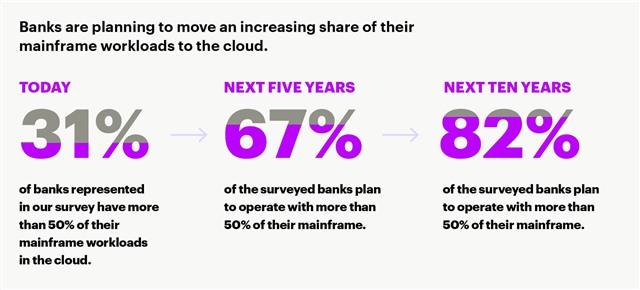Moving and Modernizing Mainframe Apps to The Cloud Goes Mainstream
Mainframe applications are on a modernization journey, as enterprises move their business-critical systems to the cloud.
Across the industry, there is a dramatic shift in the way organizations perceive the value that the mainframe can deliver. Often at the heart of many organizations, the mainframe is the workhorse delivering enterprise-grade performance and reliability. But many organizations are moving to the cloud so they can take advantage of the scalability and cost-effectiveness it can provide. Are mainframes and cloud conflicting strategies? Maybe not. Let’s explore.

A recent study by Accenture, found that four out of five banks are either planning, or actively migrating, their mainframe applications to the cloud. And they’re moving fast. The COVID pandemic accelerated the transition, as banks needed to virtualize core operations like call centers at speed. The power of the cloud enabled them to do this quickly, reducing their cost base and bringing new agility to their capacity to scale up or down as needed.
So why not do the same with core systems running on the mainframe? Even though these systems are exceptionally large - typically running tens or hundreds of millions of lines of code written in COBOL - it is now possible to re-platform them with minimal change to x86 architectures running in the cloud, which is allowing banks to unlock their 30-year investment and modernize their core applications with microservices and APIs. Add significant savings in Infra-structure costs, it’s a no-brainer.
And confidence in the process grows as more and more successful examples are published. Santander recently announced that it has moved 80% of their IT infrastructure to the cloud which gives their thousands of developers a platform for modernization, faster response times and a 70% reduction in energy consumption.
But it is not just banks that are moving off the mainframe – it’s happening across many sectors from insurance, manufacturing, airlines, and retailers. K-Mart’s rapid growth and need for a faster response to changing business demands, led them to change their 25-year reliance on mainframe infrastructure by deploying their core business applications in the AWS cloud using Rocket® Enterprise Suite (formerly part of Micro Focus) technology.
In fact, so pervasive is this industry-wide move of mainframe workloads into the cloud, that the major cloud providers themselves are investing heavily in their mainframe modernization strategies. They can see that if they don’t support this shift, their competitors will. And there’s more at stake than migration alone. Winners in this space will get the lion’s share of the workload coming off the mainframe, but also the additional cloud services that these platforms enable.
While all the evidence points to moving the mainframe as mainstream, it can seem like a daunting task. Where to start? Hesitation is understandable, but unnecessary. Rocket Software has been in the mainframe application business for over 30 years. We know this is no ‘lift and shift’. This is a significant transition of business systems - and value - to a new architecture. In the past 12 years alone, we have helped over 600 customers move their mainframe workloads onto alternative platforms - that’s more than one completed every week.
What began as small discrete workloads in the early 2000s, moving on-premise data centres has become a groundswell of the largest customers globally, moving incredibly complex business applications directly to the cloud. Meanwhile, Rocket Software’s experience and technology has evolved to the point where our expertise in moving workloads to cloud or distributed platforms with minimal changes is unmatched. And by taking advantage of modern development tools and application knowledge, customers can accelerate the delivery of change, repurposing existing business functions to deliver new capabilities at pace and exploiting the services the cloud provides.
But having great technology isn’t enough. Our modernization maturity model, together with our unique approach to helping customers determine their modernization strategy, has been developed in close collaboration with our customers and our partners across hundreds of implementations. It shapes how we evolve our technology and enables us to answer any customer concerns relating to moving off the mainframe.
I’m not saying that a move from the mainframe to the cloud will be plain sailing. After all, we’re talking about moving complex, critical business systems. But increasing numbers of enterprises are successfully taking this approach, cloud vendors have the platforms and services to support your business applications, and we at Rocket Software have the technology and experience to support your transition and allow you to modernize your applications and deliver new services at pace.
There has never been a better time to take the plunge, go mainstream, and harness the power of the cloud to drive your mainframe apps.
Related posts
New Era of Mainframe Modernization with IBM z17
Mainframes are not just alive—they’re thriving.
Welcome to Modernization. Without Disruption.
We meet you wherever you are and tailor our strategies to align with your specific goals and objectives.
Survey on the Importance of Mainframes and COBOL
Let’s dive into the resilience and evolution of mainframes and COBOL with insights from a recently commissioned Vanson Bourne survey.